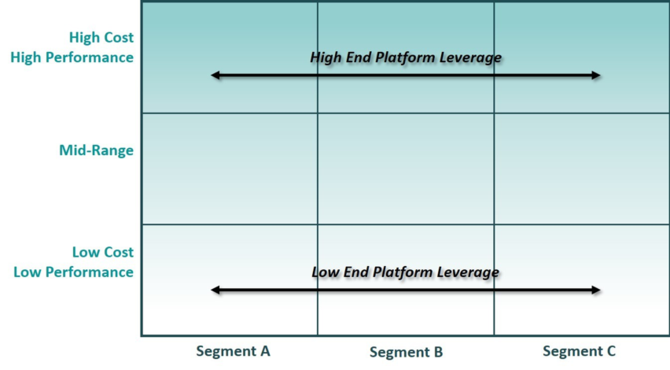
The Strategic use of Business Platforms
By Kent Thorén and Maria Kanov
Many companies look towards platforms in the hope that they can give advantage over competitor and enable future business expansions. Given this interest, and requests from readers of the digitalization articles, a discussion on the topic seems warranted.
According to Prof. Mark Meyer a platform is “a set of subsystems and interfaces that form a common structure from which a stream of derivative products can be efficiently developed and produced”. Examples of successful platforms are Apple, eBay, Microsoft, Amazon, Facebook, General Electrics, Samsung, Virgin Group, Philips, etc. Even though their businesses lie in very different fields, they have at least two things in common: They are all highly profitable and enjoy enormous capital market valuations (so it is thus not surprising that many business leaders want to learn the secrets behind their success). But they also target a broad range of customers, enabled by platforms allowing product development initiatives to be done at comparatively low risk compared to working with freestanding efforts.
Traditionally business models got shaped when companies designed and produced a specific product or service that could be sold for a price sufficiently larger than the costs incurred. Platform strategies, on the other hand, focus on enabling a common framework for value propositions that can be adapted to many market segments. This strategy is particularly powerful in the digital domain, where it is relatively easy to create the necessary value-enabling point in time-space that can facilitate a multitude of transactions and connect to extremely large audiences regardless of their location.

Deloitte distinguishes between three types of platforms: i) Aggregation platforms that facilitate transactions, ii) Social platforms that facilitates interaction between individuals and communities, and iii) Mobilization platforms that help people to act together.
Platform Advantages
In business strategies platforms can enable business model advantages such as:
- Flexibility to support many different business ideas, in contrast to infrastructures from which only one or a few value propositions can be produced.
- Scalability allowing for the volume to increase substantially without causing any need for major reconfiguration of production infrastructure or for making large investments to overcome production limitations (so called “step costs”). A necessary requirement for the holy grail of exponential growth.
- Scopability, if such a word exists (now it does!), or the flexibility of platform to support a variety of offers being used to enhance diversity, thereby giving buyers a larger number of reasons to visit and, in extension, bestowing the strategic position of a place to look for just about anything, c.f. Amazon.
- Mass customization, which means breaking the traditional trade-off between volume and costs versus customer adaptation of products or services. Customization increases value by improved targeting of precise customer needs. Unfortunately, it also brings costs of adaptation that can, by definition, not be reduced by economies of scale (modularization might help though). With clever digital transaction platforms, however, recombinability can be very high while flexible automatization help keeping production costs down. Dell is a well-known pioneer of this strategy.
- Potential openness to other actors who want to offer their products or services on the platform. In principle, a platform owner does not necessarily have to provide any product or service to end customers, but can let such “complementors” build the entire inventory. Used well, this advantage reduces risk as well as limitations to scale and scope of platform offers, c.f. eBay.
An example of an open platform company is Furhat Robotics who offer a socially intelligent robot, run on an operating system with principles of human behavior as building blocks, which functions users can tailor freely using APIs.

Furhat platform, adapted from Lin et al (2007)
Key Elements of a Platform Strategy
There are at least four aspects to consider carefully when defining a platform strategy:
- Scope of the firm: The scope choices defines a clear line on where and for what to employ internal efforts and where to involve outside complementors.
- Relationships with external complementors: The relations to external parties must be defined as either collaborative or competitive in nature, while maintaining a healthy balance and the ability to adjust over time.
- Internal organization: A stable internal structure with appropriate ways of communication might help prevent potential conflicts and confusion.
- Platform technology: Clear decisions must be made about the platform architecture, the openness of interfaces, and the degree of modality.

Attracting complementors is especially important. These are key actors in a digital platform ecosystem that develop complementary products, which often makes them indispensable for a platform’s success. Complementors can also bring in skills that the platform owner does not have, or provide valuable resources such as supplementary capital and relationships that can help the platform company to grow faster. A general recommendation for platform leaders is therefore to expand the platform’s transaction opportunities in order to assist complementors to build more applications and to boost the ecosystem.
Horizontal and Vertical Strategy
In diversified firms, platforms can be used for horizontal strategy, which allows for sustainable synergies between different companies or business units. These synergies can be leveraged for significant competitive advantage over other corporations. In horizontal leveraging, the platform is used to serve several different market niches, on different performance levels or price ranges. It makes it possible to target a broad range of customers within different target markets by applying minor changes to a stream of end products, rather than having to start and develop an offer for each segment from scratch. A rudimentary example of horizontal leveraging is Gilette selling the same razor blades to both men and women but with superficial design and packaging differences.

Horizontal Leveraging Strategy (Meyer, 1997)
This approach stands in contrast to vertical scaling, as depicted below. In this strategy the company remains within one single market segment but tries to apply the product platform to several different performance or price ranges. This can be done by adding or removing certain features or functions to obtain an altered version of the end product and ultimately attract a larger number of customers by covering more of the segment. One example would be the iPad. Apple sells different versions of this product in various price ranges to engage a heterogenous customer group.

Vertical Scaling Strategy (Meyer, 1997)
Using Platforms for Beach-head Strategy
Given that platforms can be designed to serve multiple product-market combinations, the opportunity to sequence strategy through making moves in a selected order becomes available. As a general market expansion strategy, the idea of sequencing is to increase growth potential and chances for success by designing a progression of subsequent entry, starting with the “easiest” market first and then moving into adjacent markets one by one as they become addressable. Sequencing combines the horizontal and vertical approach by for instance developing a low-cost platform that targets one specific customer segment first and thereafter scaling towards other segments. It is considered to be one of the most effective strategic applications of platforms, but difficult to implement.

The Beachhead Platform Strategy (Meyer & Lehnerd, 1997)
Some Challenges
Being able to sell a product to various groups of customers comes with the clear benefits of saving costs, e.g. in the manufacturing process, a decrease of development lead times by splitting ground work on the platform level from the rest, as well as serving a larger part of the market. If the platform becomes the industry standard, it even allows for durable market dominance thereby raising barriers to entry for competitors. All these benefits suggest the feasibility of a strong competitive advantage.
On the other side, there are also downsides associated to the strategy, which should not be neglected. Even if a company manages to become a platform leader, it is often difficult to preserve integrity and guarantee compatibility with future complementary innovations in the long run. Moreover, when platforms evolve over time, assuring the backwards compatibility with the previous generation is another struggle. A third issue is how to keep a platform leadership position in the long run. However, the main hurdle before a platform gets adopted does not seem to concern the technical aspects, but rather the business model design, people management, and organizational issues (such as communication and organizational structure).
Inspiration
Cusumano, M.A., Gawer, A. (2008). How Companies Become Platform Leaders. MIT Sloan Management Review, 49(2), 28-35.
Deloitte analysis. (2015) Business ecosystems come of age
Gawer, A. (2009). Platforms, Markets and Innovation. Edward Elgar Publishing.
Ghanam, Y., Maurer, F., Abrahamsson, P. (2012). Making the Leap to a Software Platform Strategy: Issues and challenges. Information and Software Technology, 54(9), 968-984.
Kanov M. (2017). Creating a Platform as a Startup: A high risk but high reward Journey – A Case Study on Furhat Robotics, Minor Thesis, KTH Royal Institute of Technology.
Ku, S.W., Cho, D.S. (2011). Platform Strategy: An empirical Study on the Determinants of Platform Selection of Application Developers. Journal of International Business and Economy, 12(1), 123-143.
Lin, L.H., Tanyavutti, A., Jindrapacha, S. (2007). Analyzing eBay Platform Strategies: An Application of Meyer’s Product Platform Strategy Model. PICMET 2007 Proceedings,125-142.
Marion, T.J., Simpson, T.W. (2006). Platform Leveraging Strategies and Market Segmentation. In Simpson, T.W., Siddique, Z., Jiao, J. (Ed.), Product Platform and Product Family Design (73-90). Springer Science+Business Media.
Meyer, M.H. (1997). Revitalize Your Product Lines Through Continuous Platform Renewal. Research-Technology Management, 42(2), 17-28.
Meyer, M.H., Lehnerd, A.P. (1997). The Power of Product Platforms. The Free Press.
Muffatto, M. (1999). Introducing a Platform Strategy in Product Development. International Journal of Production Economics, 60-61(1), 145-153.
